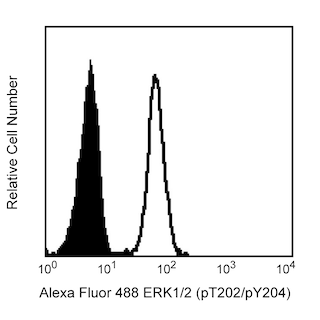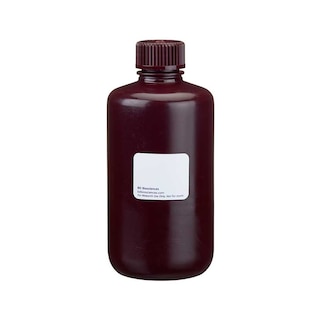Old Browser
This page has been recently translated and is available in French now.
Looks like you're visiting us from {countryName}.
Would you like to stay on the current country site or be switched to your country?




.png)

Two-color flow cytometric analysis of NCAM-1 (CD56) expression by fixed and permeabilized human peripheral blood lymphocytes. Erythrocytes were lysed and leucocytes were fixed and permeabilized in a human whole blood sample using 1X BD Phosflow™ Lyse/Fix Buffer (Cat. No. 558049; 10 min, 37˚C) followed by BD Phosflow™ Perm Buffer III (Cat. No. 558050; 30 min, on ice). The leucocytes were then stained with PE Mouse Anti-Human NCAM-1 (CD56) (Cat. No. 563238) and BD Horizon™ BV421 Mouse Anti-Human CD3 (Cat. No. 562426/562427) antibodies. The two-color flow cytometric dot plot shows the correlated expression patterns of CD3 versus NCAM-1 (CD56) for gated events with the forward and side light-scatter characteristics of intact peripheral blood lymphocytes. Flow cytometric analysis was performed using a BD FACSCanto™ II Flow Cytometry System.

Two-color flow cytometric analysis of NCAM-1 (CD56) expression on live-stained human peripheral blood lymphocytes. Whole blood was stained with PE Mouse Anti-Human NCAM-1 (CD56) (Cat. No. 563238) and BD Horizon™ BV421 Mouse Anti-Human CD3 (Cat. No. 562426/562427) antibodies. Erythrocytes were lysed with BD FACS Lysing Solution (Cat: 349202). The two-color flow cytometric dot plot shows the correlated expression patterns of CD3 versus NCAM-1 (CD56) for gated events with the forward and side light-scatter characteristics of intact peripheral blood lymphocytes. Flow cytometric analysis was performed using a BD FACSCanto™ II Flow Cytometry System.
.png)

BD Pharmingen™ PE Mouse Anti-Human NCAM-1 (CD56)

BD Pharmingen™ PE Mouse Anti-Human NCAM-1 (CD56)
.png)
Regulatory Status Legend
Any use of products other than the permitted use without the express written authorization of Becton, Dickinson and Company is strictly prohibited.
Preparation And Storage
Recommended Assay Procedures
The R19-760 antibody may be used for both intracellular and cell-surface flow cytometric applications. For intracellular flow cytometry, various fixatives and permeabilization buffers are suggested (see Suggested Companion Products).
Product Notices
- This reagent has been pre-diluted for use at the recommended Volume per Test. We typically use 1 × 10^6 cells in a 100-µl experimental sample (a test).
- An isotype control should be used at the same concentration as the antibody of interest.
- Brilliant Violet™ 421 is a trademark of Sirigen.
- Source of all serum proteins is from USDA inspected abattoirs located in the United States.
- Caution: Sodium azide yields highly toxic hydrazoic acid under acidic conditions. Dilute azide compounds in running water before discarding to avoid accumulation of potentially explosive deposits in plumbing.
- For fluorochrome spectra and suitable instrument settings, please refer to our Multicolor Flow Cytometry web page at www.bdbiosciences.com/colors.
- Please refer to www.bdbiosciences.com/us/s/resources for technical protocols.
Companion Products






The R19-760 monoclonal antibody specifically binds to NCAM-1 (Neural cell adhesion molecule 1) that is also known as CD56 and NKH1. NCAM-1 is a heavily glycosylated transmembrane protein and a member of the Ig supergene family. NCAM-1 represents an isoform of the neural cell adhesion molecule (NCAM). In the hematopoietic system, it is present on approximately 10% to 25% of peripheral blood lymphocytes. It is expressed on natural killer (NK) cells and a subset of T cells, NKT cells. It is not expressed on myeloid cells, erythrocytes or B cells. This molecule appears to function as an adhesion molecule and can serve as a panspecific NK-cell marker. The R19-760 antibody recognizes an epitope in the NCAM-1 (CD56) extracellular domain that resists destruction due to cellular fixation with BD Phosflow™ Lyse/Fix Buffer and permeabilization with BD Phosflow™ Perm Buffer III.

Development References (14)
-
Bennett IM, Zatsepina O, Zamai L, Azzoni L, Mikheeva T, Perussia B. Definition of a natural killer NKR-P1A+/CD56-/CD16- functionally immature human NK cell subset that differentiates in vitro in the presence of interleukin 12. J Exp Med. 1996; 184(5):1845-1856. (Biology). View Reference
-
Campbell JJ, Qin S, Unutmaz D, et al. Unique subpopulations of CD56+ NK and NK-T peripheral blood lymphocytes identified by chemokine receptor expression repertoire. J Immunol. 2001; 166(11):6477-6482. (Biology). View Reference
-
Cooper MA, Fehniger TA, Caligiuri MA. The biology of human natural killer–cell subsets. Trends Immunol. 2001; 22(11):633-640. (Biology). View Reference
-
Cunningham BA, Hemperly JJ, Murray BA, Prediger EA, Brackenbury R, Edelman GM. Neural cell adhesion molecule: structure, immunoglobulin-like domains, cell surface modulation, and alternative RNA splicing. Science. 1987; 236(4803):799-806. (Biology). View Reference
-
Edelman GM. Cell adhesion molecules in the regulation of animal form and tissue pattern. Annu Rev Cell Biol. 1986; 2:81-116. (Biology). View Reference
-
Galandrini R, Tassi I, Mattia G, et al. SH2-containing inositol phosphatase (SHIP-1) transiently translocates to raft domains and modulates CD16-mediated cytotoxicity in human NK cells. Blood. 2001; 100(13):4581-4589. (Biology). View Reference
-
Gerosa F, Baldani-Guerra B, Nisii C, Marchesini V, Carra G, Trinchieri G. Reciprocal activating interaction between natural killer cells and dendritic cells. J Exp Med. 2002; 195(3):327-333. (Biology). View Reference
-
Lanier LL, Chang C, Azuma M, Ruitenberg JJ, Hemperly JJ, Phillips JH. Molecular and functional analysis of human natural killer cell-associated neural cell adhesion molecule (N-CAM/CD56). J Immunol. 1991; 146(12):4421-4426. (Biology). View Reference
-
Lanier LL, Le AM, Civin CI, Loken MR, Phillips JH. The relationship of CD16 (Leu-11) and Leu-19 (NKH-1) antigen expression on human peripheral blood NK cells and cytotoxic T lymphocytes. J Immunol. 1986; 136(12):4480-4486. (Biology). View Reference
-
Lanier LL, Testi R, Bindl J, Phillips JH. Identity of Leu-19 (CD56) leukocyte differentiation antigen and neural cell adhesion molecule. J Exp Med. 1989; 169(6):2233-2238. (Biology). View Reference
-
Nitta T, Yagita H, Sato K, Okumura K. Involvement of CD56 (NKH-1/Leu-19 antigen) as an adhesion molecule in natural killer–target cell interaction. J Exp Med. 1989; 170(5):1757-1761. (Biology). View Reference
-
Phillips JH, Lanier LL. Dissection of the lymphokine-activated killer phenomenon: relative contribution of peripheral blood natural killer cells and T lymphocytes to cytolysis. J Exp Med. 1986; 164(3):814-825. (Biology). View Reference
-
Ritz J, Trinchieri G, Lanier LL. NK-cell Antigens: Section Report. In: Schlossman SF. Stuart F. Schlossman .. et al., ed. Leucocyte typing V : white cell differentiation antigens : proceedings of the fifth international workshop and conference held in Boston, USA, 3-7 November, 1993. Oxford: Oxford University Press; 1995:1367-1372.
-
Schubert W, Zimmermann K, Cramer M, Starzinski-Powitz A. Lymphocyte antigen Leu-19 as a molecular marker of regeneration in human skeletal muscle. Proc Natl Acad Sci U S A. 1989; 86(1):307-311. (Biology). View Reference
Please refer to Support Documents for Quality Certificates
Global - Refer to manufacturer's instructions for use and related User Manuals and Technical data sheets before using this products as described
Comparisons, where applicable, are made against older BD Technology, manual methods or are general performance claims. Comparisons are not made against non-BD technologies, unless otherwise noted.
For Research Use Only. Not for use in diagnostic or therapeutic procedures.
Report a Site Issue
This form is intended to help us improve our website experience. For other support, please visit our Contact Us page.